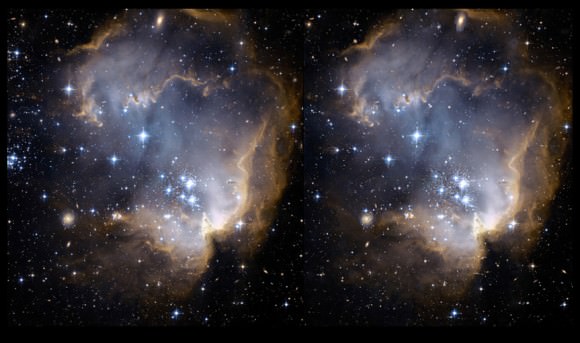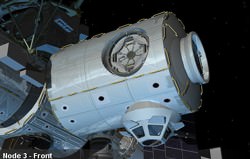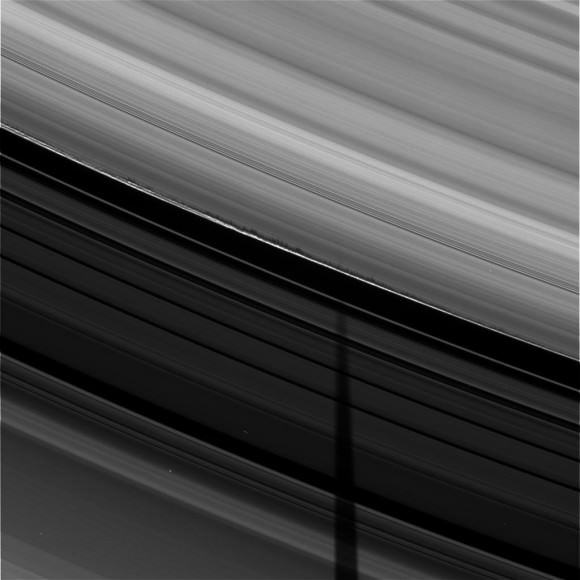NASA Science News for April 17, 2009
A meteor shower. A crescent Moon. A disappearing planet. These three things will be on display next Wednesday, April 22nd, when the Moon occults Venus during the annual Lyrid meteor shower.
FULL STORY at
http://science.nasa.gov/headlines/y2009/17apr_lyrids.htm?list1035898
Check out our RSS feed at http://science.nasa.gov/rss.xml!
Dust Storms Picking Up on Mars
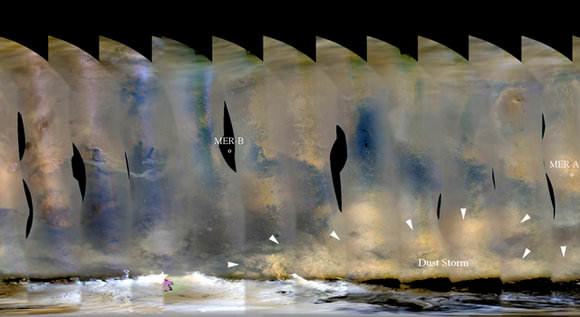
Just like hurricane season or tornado season on Earth, Mars has stormy seasons, too. However, the Red Planet has dust storms, and they can be whoppers, which is bad news for the two Mars rovers, Spirit and Opportunity who rely on clear skies and sunshine for power. On April 21, Mars will be at the closest point to the sun in the planet’s 23-month, elliptical orbit. One month later, the planet’s equinox will mark the start of summer in Mars’ southern hemisphere. This atmospheric-warming combination makes the coming weeks the most likely time of the Martian year for dust storms, and given the current forecast based on data from the orbiting Mars Reconnaissance Orbiter and Mars Odyssey, these storms could be severe enough to minimize activities of the rovers.
(...)
Read the rest of Dust Storms Picking Up on Mars (600 words)
Constraining the Orbits of Planet X and Nemesis
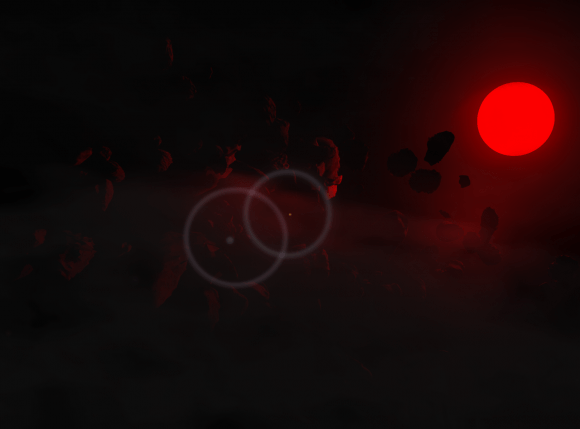
Artists impression of the hypothetical star, Nemesis (Wikipedia)
If Planet X was out there, where would it be? This question posed by an Italian researcher turns out to be a lot more involved than you’d think. As opposed to all the 2012 idiocy hype flying around on the internet, this research is actually based on a little thing called science. By analysing the orbital precession of all the inner-Solar System planets, the researcher has been able to constrain the minimum distance a hypothetical object, from the mass of Mars to the mass of the Sun, could be located in the Solar System. As most of the astronomical community already knows, the two purveyors of doom (Planet X and the Sun’s evil twin, Nemesis) exist only in the over-active imaginations of a few misinformed individuals, not in reality…
(...)
Read the rest of Constraining the Orbits of Planet X and Nemesis (579 words)
Bridge Between the Stars - NGC 602: Hubble Visualization by Jukk
It’s been awhile hasn’t it? Time may have passed, but absence makes the heart grow fonder. For those of you who have missed our very special dimensional looks into the Cosmos, then it’s high time we let our minds and eyes relax and we take a 200 thousand light-year distant journey towards the edge of the Small Magellanic Cloud for a look at a bright, young open cluster of stars known as NGC 602… (...)
Read the rest of Bridge Between the Stars - NGC 602: Hubble Visualization by Jukka Metsavainio (843 words)
Kepler’s “First Light” Images
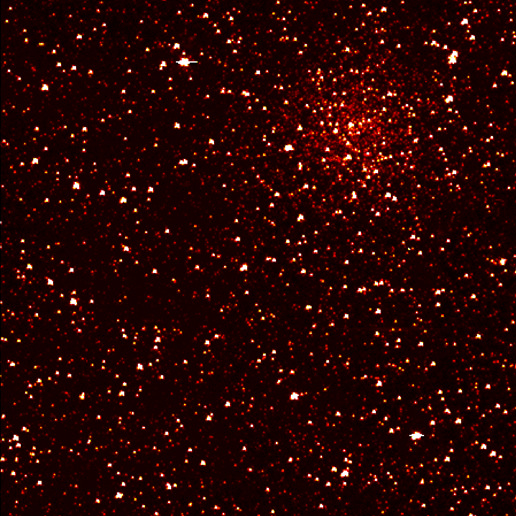
W00t! Kepler has seen first light! The spacecraft has taken its first images of the star-rich sky where it will soon begin hunting for planets like Earth. These first images show the mission’s target patch of sky, a vast starry field in the Cygnus-Lyra region of our Milky Way galaxy. One image shows millions of stars in Kepler’s full field of view, while two others zoom in on portions of the larger region. “Kepler’s first glimpse of the sky is awe-inspiring,” said Lia LaPiana, Kepler’s program executive at NASA Headquarters in Washington. “To be able to see millions of stars in a single snapshot is simply breathtaking.”
The image above zooms into a small portion — just 0.2 percent –of Kepler’s full field of view, and shows an an expansive, 100-square-degree patch of sky in our Milky Way galaxy, and a cluster of stars located about 13,000 light-years from Earth, called NGC 6791, can be seen in the upper right corner. These images were taken on April 8, 2009, one day after Kepler’s dust cover was jettisoned. See more below.
(...)
Read the rest of Kepler’s “First Light” Images (459 words)
NASA Worried: Spirit Reboots Rover Computer, Twice
Mars Exploration Rover Spirit is acting a little strange. Over the Easter weekend, it would appear that the tenacious little Mars explorer rebooted its computer not once, but at least two times. Mission scientists were alerted to the problem as some of the communication sessions from Spirit-to-Earth were irregular, prompting mission control to investigate the problem…
(...)
Read the rest of NASA Worried: Spirit Reboots Rover Computer, Twice (320 words)
Incredible Light Show: Gas Jet Flaring From M87’s Black Hole
Sometimes reality is stranger than fiction. The Hubble Space Telescope has been keeping an eye on the very active galaxy M87 for years, and has now captured a flare-up in a jet of matter blasting from the galaxy’s monster black hole. This 5,000-light-year-long, narrow beam of radiation and plasma is as bright as a Star Wars light saber and as destructive as the Death Star. This extragalactic jet is being fueled and ejected from the vicinity of a monster black hole that is 3 billion times the mass of our Sun. “I did not expect the jet in M87 or any other jet powered by accretion onto a black hole to increase in brightness in the way that this jet does,” says astronomer Juan Madrid of McMaster University in Hamilton, Ontario. “It grew 90 times brighter than normal. But the question is, does this happen to every single jet or active nucleus, or are we seeing some odd behavior from M87?”
(...)
Read the rest of Incredible Light Show: Gas Jet Flaring From M87’s Black Hole (660 words)
Catching Up With Comet Yi-SWAN
Now that the Moon is out of the early evening sky, far northern observers are out in force hunting down Comet C/2009 Yi-SWAN… and it’s there! In 10X50 binoculars it appears like a very faint, small globular cluster, but definitely has the signature of a comet in a 4.5″ telescope. Surprisingly enough, it’s not very hard to find. Would you like a hand? (...)
Read the rest of Catching Up With Comet Yi-SWAN (167 words)
COLBERT on the ISS
There will be a COLBERT on the International Space Station. Word has it that NASA, however, did not name Node 3 on the ISS after comedian Stephen Colbert, who won a NASA-sponsored naming contest for the next module that will be brought to the station. According to Robert Pearlman on CollectSPACE, NASA will announce on Comedy Central’s “Colbert Report” later tonight (Tuesday) that the module’s name will be “Tranquility” – in deference to Apollo 11’s landing site on the Moon (40th anniversary and all this year). But NASA did name a new treadmill after Colbert, kinda sorta. NASA created an acronym for the treadmill as the Combined Operational Load Bearing External Resistance Treadmill, or COLBERT. Of course, this isn’t actually official yet. Pearlman’s article was published two hours before the “Colbert Report” aired (even though NASA’s press release specificially stated the name would “not be publicly released until the program airs.” Hmmm… guess nothing is sacred. We’ll post the video and official word when available. You can see an image of the current treadmill on the ISS below.
(...)
Read the rest of COLBERT on the ISS (40 words)
NASA Science News for April 14, 2009
For the first time, NASA spacecraft have traced the 3D shape of solar storms known as coronal mass ejections (CMEs). It turns out the most ferocious storms resemble something from a French bakery. Read today's story to find out what:
http://science.nasa.gov/headlines/y2009/14apr_3dcme.htm?list1035898
Check out our RSS feed at http://science.nasa.gov/rss.xml
New story for 2009/04/13
Cassini’s Indirect Image of Boulders and Moonlets in Saturn’s Rings
Take a look at this — its absolutely stunning. A couple of weeks ago, Anne wrote an article about shadows on Saturns rings. Because Saturn is approaching its equinox, in August the rings will “disappear” from our view from Earth, as the rings will be exactly edge-on. But as the rings ease into alignment with the sun, Saturn’s moons cast their shadows across the rings, growing longer as equinox approaches. See in the image above, a shadow is cast on the rings, likely by either the moon Mimas or Tethys. But the eagle-eyed folks over at UnmannedSpaceflight.com also noticed something else in this raw image from the Cassini spacecraft. Notice the area right near the middle of the image where the rings look kind of fuzzy? That’s not just camera blur; those are more shadows, created by thousands of boulders or moonlets in the ring! Amazing! We’ve never actually seen the small objects that make up the rings — and we still haven’t — but we’re seeing the shadows they are creating! Let’s zoom in for a closer look:
(...)
Read the rest of Cassini’s Indirect Image of Boulders and Moonlets in Saturn’s Rings (196 words)
Take a look at this — its absolutely stunning. A couple of weeks ago, Anne wrote an article about shadows on Saturns rings. Because Saturn is approaching its equinox, in August the rings will “disappear” from our view from Earth, as the rings will be exactly edge-on. But as the rings ease into alignment with the sun, Saturn’s moons cast their shadows across the rings, growing longer as equinox approaches. See in the image above, a shadow is cast on the rings, likely by either the moon Mimas or Tethys. But the eagle-eyed folks over at UnmannedSpaceflight.com also noticed something else in this raw image from the Cassini spacecraft. Notice the area right near the middle of the image where the rings look kind of fuzzy? That’s not just camera blur; those are more shadows, created by thousands of boulders or moonlets in the ring! Amazing! We’ve never actually seen the small objects that make up the rings — and we still haven’t — but we’re seeing the shadows they are creating! Let’s zoom in for a closer look:
(...)
Read the rest of Cassini’s Indirect Image of Boulders and Moonlets in Saturn’s Rings (196 words)
NASA Science News_April10,2009
News
NASA Science News for April 10, 2009
NASA researchers are about to climb the slopes of Earth's tallest mountain to test exploration technologies they'll need on the Moon and Mars.
FULL STORY at
http://science.nasa.gov/headlines/y2009/10apr_because.htm?list1035898
Check out our RSS feed at http://science.nasa.gov/rss.xml!
NASA Science News_April 9, 2009
News
NASA Science News for April 9, 2009
NASA's twin STEREO probes are entering a mysterious region of space to look for remains of an ancient planet which might have orbited the Sun not far from Earth. If they find anything, it could solve a major puzzle--the origin of the Moon.
FULL STORY at
http://science.nasa.gov/headlines/y2009/09apr_theia.htm?list1035898
